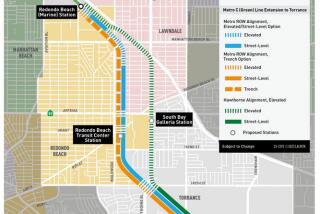Letters: Second thoughts on California’s bullet train
Re“Rail line’s Big Dig,” Nov. 13
FOR THE RECORD:
Bullet train: In the “Train to somewhere” letters to the editor on Nov. 16, the word “million” was missing in this quote: “Fully operational, the bullet train will need an estimated 2.7 million kilowatt hours of electricity every day.”
I am old enough to think that not much can astound or surprise me. But the article on the bullet train construction did just that.
The enormous challenges of construction, and the cost estimates that keep going up, should be enough to amaze. But what really caught my eye was the line that reads: “Fully operational, the bullet train will need an estimated 2.7 kilowatt hours of electricity every day — about a quarter of Hoover Dam’s daily output.”
Where will that power come from?
I would suspect that a very small percentage of Californians will ever use the train. Vast sums for construction in a state with serious financial problems, enormous operating expense, taking huge resources to operate? No wonder many people vote against any kind of tax increase, when they see a project like this with so much money spent to benefit so few.
I find that I am not too old to be astounded. The project should not go forward.
Chris Keller
West Covina
Unbridled hubris. We are victims of megalomaniacal delusions of engineering grandeur. The details of the high-speed rail system revealed in the front-page article show exactly how fragile the proposed plan for the bullet train is.
I was a fan of the grand idea years ago when it was presented on a two-dimensional map. I was a detractor of the revised map when it was presented as a route to nowhere, with no population centers at either terminus.
Today I am appalled at the revelation of the engineering hurdles required, when the seismic intersections and three-dimensional challenges are actually acknowledged and a terminus is incorporated in the plan.
And 2.7 million kilowatt hours of electrical power a day? Where does that come from?
The whole concept now appears to be ill-conceived, ill-considered and ill-confronted.
Ted McKinney
Riverside
The glowing descriptions of this “engineering marvel,” with sections that “soar over canyons on viaducts as high as a
33-story skyscraper,” do little to bring the impact on humans into focus.
Current plans for the route take it through populated areas, when alternatives are available. Why not take the train through the Angeles National Forest rather than the populated portions of unincorporated L.A. County?
Voters approved the initial project in 2008 only to have the California High-Speed Rail Authority publish a revised cost estimate last year of more than $65 billion.
Perhaps this project should be brought back to the voters to see if the revised costs are still within the tolerance window of those who must live with it going forward.
Don Wright
Acton
In thinking about the big project that is the bullet train, details are important too.
Depending on the exact route taken, crossing two mountain ranges may require several tunnels, tall bridges and construction to withstand earthquakes.
Tunneling machines work hard. They consume lots of energy to build the rail tunnels that aim to minimize energy use later, through fewer car trips and plane flights. (The nonpartisan Congressional Budget Office calculated circumstances in which rail tunneling offset energy savings gained by reduced vehicle trips with rail use. Adding construction and operation, the result was sometimes “higher” net long-term energy use than without rail.)
Tall, earthquake-resistant bridges take a lot of concrete. Manufacturing cement for concrete produces greenhouses gases, as a Berkeley study notes, although these emissions can be reduced.
In considering whether to build the bullet train and, if so, choosing its route, the long-term environmental consequences of both construction and operation should be weighed. And pay attention both to the big picture and the details.
Mark David Menchik
San Diego
It’s time for the Democrats in Sacramento to start acting rationally about high-speed rail. The cows and farmhands in the Central Valley will not be riding the bullet train.
What we need and what will work is a high-speed train from L.A. to San Diego. Building this train route and the associated feeder links would be a public benefit and would demonstrate that the politicians can take intelligent action to solve our traffic problems and give taxpayers real-time bang for the buck.
Rather than building a train to nowhere, our leaders should take the initiative to clear the way and build a train we can use by the end of this decade.
Ron Steffen
Calabasas
This project is going to make Boston’s “Big Dig” fiasco seem like one shovelful of top soil.
But I should be reasonable — there are reasons to go to Bakersfield. Imagine that there are two cowboys in a bar in downtown Los Angeles. After the third pitcher of beer, the conversation turns to whether the beer they’ve been drinking is as good as the beer at the Country Bunker in Bakersfield. So, they stagger over to the bullet train, hop on, and in mere moments they’re able to make that call.
If California wants to squander upward of $70 billion, I can think of no better way to do it — and then the state really will be finished.
Gene Miller
Huntington Beach
More letters to the editor ...
More to Read
A cure for the common opinion
Get thought-provoking perspectives with our weekly newsletter.
You may occasionally receive promotional content from the Los Angeles Times.









